#9th century BC
Text
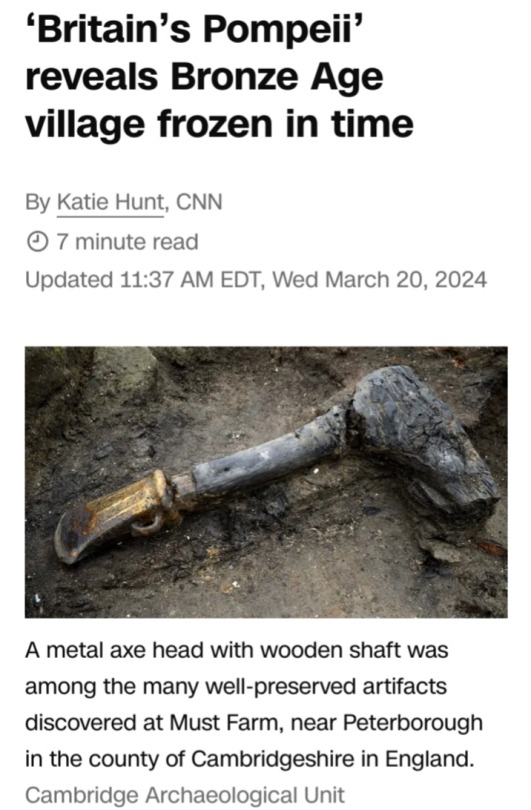
(CNN) — It’s late summer 2,850 years ago. A fire engulfs a stilt village perched above a boggy, slow-moving river that weaves though the wetlands of eastern England.
The tightly packed roundhouses, built from wood, straw, turf, and clay just nine months earlier, go up in flames.
The inhabitants flee, leaving behind all their belongings, including a wooden spoon in a bowl of half-eaten porridge.
There is no time to rescue the fattened lambs, which are trapped and burnt alive.
The scene is a vivid and poignant snapshot, captured by archaeologists, of a once thriving community in late Bronze Age Britain known as Must Farm, near what’s now the town of Peterborough.
The research team published a two-volume monograph on Wednesday that describes their painstaking $1.4 million (£1.1 million) excavation and analysis of the site in the county of Cambridgeshire.
Described by the experts involved as an “archaeological nirvana,” the site is the only one in Britain that lives up to the “Pompeii premise,” they say, referencing the city forever frozen in time by the eruption of Mount Vesuvius in AD 79 that has yielded unparalleled information about ancient Rome.
“In a typical Bronze Age site, if you’ve got a house, you’ve probably got maybe a dozen post holes in the ground and they’re just dark shadows of where it once stood.
If you’re really lucky, you’ll get a couple of shards of pottery, maybe a pit with a bunch of animal bones.
This was the complete opposite of that process. It was just incredible,” said Chris Wakefield of the Cambridge Archaeological Unit at the University of Cambridge, an archaeologist and member of the 55-person team that excavated the site in 2016.
"All the axe marks had been used to shape and sculpt the wood. All of those looked fresh, like they could have been done last week by someone,” Wakefield added.
The remarkably preserved condition of the site and its contents enabled the archaeological team to draw comprehensive new insights into Bronze Age society — findings that could overturn the current understanding of what everyday life was like in Britain during the ninth century BC.

Must Farm domesticity — and a mystery
The site, which dates to eight centuries before Romans arrived in Britain, revealed four roundhouses and a square entranceway structure, which stood approximately 6.5 feet (2 meters) above the riverbed and were surrounded by a 6.5-foot (2-meter) fence of sharpened posts.
The archaeologists believe the settlement was likely twice as big. However, quarrying in the 20th century destroyed any other remains.
Though charred from the fire, the remaining buildings and their contents were extremely well preserved by the oxygen-starved conditions of the fens, or wetlands, and included many wooden and textile items that rarely survive in the archaeological record.
Together, traces of the settlement paint a picture of cozy domesticity and relative plenty.
The researchers unearthed 128 ceramic artifacts — jars, bowls, cups and cookware — and were able to deduce that 64 pots were in use at the time of fire.
The team found some stored pots neatly nested.
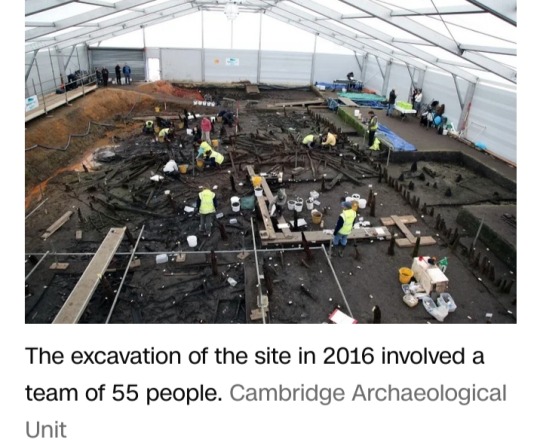
Textiles found at the site made from flax linen had a soft, velvety feel with neat seams and hems, although it wasn’t possible to identify individual pieces of clothing.
Wooden artifacts included boxes and bowls carved from willow, alder and maple, 40 bobbins, many with threads still attached, various tools, and 15 wooden buckets.
“One of those buckets … on the bottom of it were loads and loads of cut marks, so we know that people living in that Bronze Age kitchen when they needed an impromptu chopping board, were just flipping that bucket upside down and using that as a chopping surface,” Wakefield said.
“It’s those little moments that build together to give a richer, fuller picture of what was going on.”

The circumstances of the event that brought it all to a halt are still a bit of a mystery.
The researchers believe the fire took place in late summer or early autumn because skeletal remains of the lambs kept by one household showed the animals, typically born in spring, were three months to six months old.
However, what exactly caused the devastating fire remains unclear. The blaze could have been accidental or deliberately started.
The researchers uncovered a stack of spears with shafts over 10 feet (3 meters) long at the site, and many experts think that warfare was common in the time period.
The team worked with a forensic fire investigator but ultimately couldn’t identify a specific “smoking gun” clue pointing to the cause.
“An archaeological site is a lot like a jigsaw puzzle. At a typical site you have 10 or 20 pieces out of 500,” Wakefield said.
“Here, we had 250 or 300 pieces and we still couldn’t get the complete picture on how this big fire broke out.”
Mike Parker Pearson, a professor of British later prehistory at the Institute of Archaeology at University College London, described both the report and the site “as exceptional.” He wasn’t involved in the research.
“The fire may have been disastrous for the inhabitants but it is a blessing for archaeologists, a unique snapshot of life in the Bronze Age,” he said via email.
Upending ideas about Bronze Age society
The contents across the four preserved houses were “remarkably consistent."
Each one had a tool kit that included sickles, axes, gouges, and handheld razors used to cut hair or cloth.
With almost 538 square feet (50 square meters) of floor space in the largest, each of the dwellings appeared to have distinct activity zones comparable to rooms in a modern home.
“By plotting the positions of all these finds — pots, loomweights, tools, and even sheep droppings, the archaeological team have reconstructed the houses’ internal use of space,” Parker Pearson noted.
“The kitchen area was in the east, the storage and weaving area in the south and southeast with the penning area for lambs, and the sleeping area in the northwest, though we don’t know where the doorway was for each house.”
Not all the items were of practical use, such as 49 glass beads plus others made of amber.
Archaeologists also unearthed a woman’s skull, smooth from touch, possibly a keepsake of a lost loved one.
Some of the items the researchers found will go on display starting April 27 in an exhibition titled “Introducing Must Farm: A Bronze Age Settlement” at the Peterborough Museum and Art Gallery.
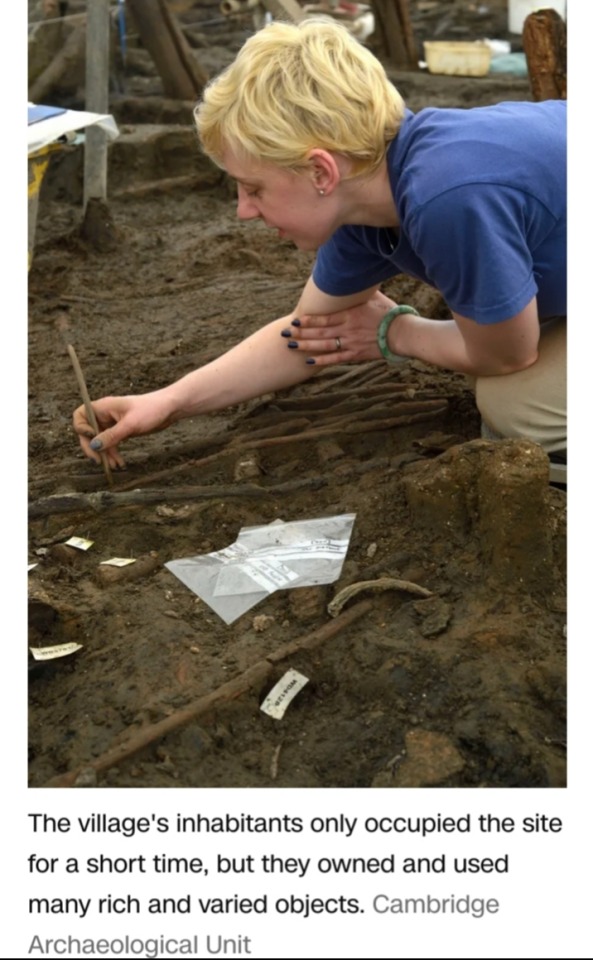
Lab analysis of biological remains revealed the types of food the community once consumed.
A pottery bowl imprinted with the finger marks of its maker held a final meal — a wheat grain porridge mixed with animal fat.
Chemical analyses of the bowls and jars showed traces of honey along with deer, suggesting the people who used the dishes might have enjoyed honey-glazed venison.
Ancient excrement found in waste piles below where the houses would have stood showed that the community kept dogs that fed on scraps from their owners’ meals.
And human fossilized poop, or coprolites, showed that at least some inhabitants suffered from intestinal worms.
The waste piles, or middens, were one line of evidence that showed how long the site was occupied, with a thin layer of refuse suggesting the settlement was built nine months to a year before it went up in flames.
"Two other factors supported that line of reasoning," Wakefield said.
“The second was that a lot of the wood that was used in the construction was unseasoned, it was still effectively green, it hadn’t been long in position,” he said.
“The third one is that we have a lack of the kind of insects and animals that are associated with human habitation."
"It wouldn’t be long before beetles would worm (in) … but there’s no evidence of any of that in any of the 18,000 plus timbers.”
The fact that the site, with its rich and varied contents, was in use for only a year upended the team’s preconceived “visions of everyday life” in the ninth century BC.
It may suggest that Bronze Age societies were perhaps less hierarchical than traditionally thought, according to the 1,608-page report.
“We are seeing here not the accumulation of a lifetime, but just a year’s worth of materials,” the authors noted in the report.
“It suggests that artefacts such as bronze tools and glass beads were more common than we often imagine and that their availability may not in fact have been restricted.”
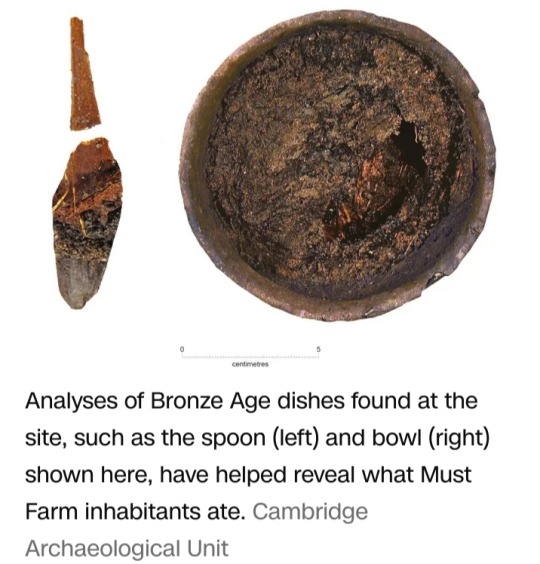
#Must Farm#Late Bronze Age#Late Bronze Age Britain#Cambridgeshire#Peterborough#archaeological nirvana#Pompeii premise#Mount Vesuvius#AD 79#Bronze Age#Chris Wakefield#Cambridge Archaeological Unit#University of Cambridge#9th century BC#Britain's Pompeii#archaeology#archaeologists#ceramic artifacts#wooden artifacts#forensic fire investigator#archaeological site#Institute of Archaeology#University College London#Peterborough Museum and Art Gallery#artefacts#Mike Parker Pearson#history
4 notes
·
View notes
Text
(List) Mother of Monsters: The Eleven Children of Tiamat - Historic Mysteries
https://www.historicmysteries.com/tiamat-monsters/
View On WordPress
#1500 BC#9th century BC#Akkadian#Amulets#Babylon#Dagon#Epic of Gilgamesh#Hydra#Kumugi#Kusarikku#Mesopotamia#Minotaur#Persian Empire#Shamash#Tiamat
2 notes
·
View notes
Text
when you're being mean to me this is who you're being mean to. btw
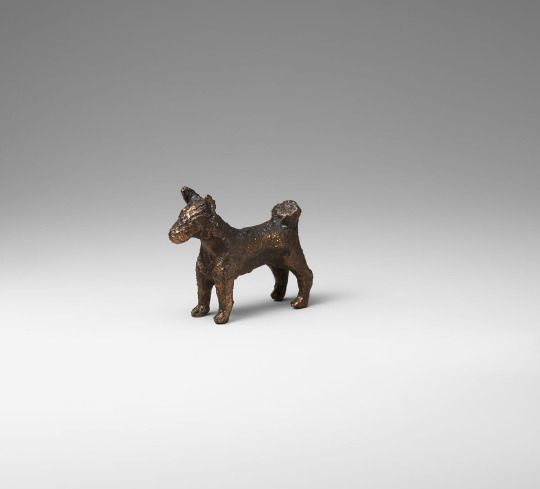
#tagamemnon#i am in fact bronze assyrian dog figurine ca. 9th-8th century bc#queueusque tandem abutere catilina patientia nostra
326 notes
·
View notes
Text

This is an outfit from when Filonyn was very young, but they do still have it. Since it was before they were living among humans, they didn’t have to wear a big hat with it.
#my art#oc tag#my ocs#monster of the week#motw#i have a lot of different period outfits for them bc they’re fun to draw#this one’s 9th century AD. they still have it though#filonyn’s closet contains some of the best preserved medieval clothes in the world#entirely because they never throw shit away and are obsessive about keeping all their clothes in good condition#they’ll occasionally break these historic garments out for the local renaissance faire#they have a booth there where they sell fabrics.#general audiences are no longer interested in old fashioned handmade textiles so they must sell at the renaissance faire#really they’d probably do numbers on any social media website but unfortunately?#their main social media presence is an account on a sewing forum that was popular in the 1990s but now has almost no users#they go on there and post extremely detailed explanations of nearly lost sewing and weaving techniques#which are only viewed by the 3 or 4 old ladies who still use the website#when i design these outfits i combine elements from both menswear and womenswear from the time period#a lot of them look very feminine by modern standards but that’s just bc men’s fashion used to be better than it is now#the miniskirt here is actually menswear inspired. no medieval woman would wear that#but men did!!!!#the bodice is based on a gown though#filonyn
6 notes
·
View notes
Text
thinking plotting etc to assign to w359 insects but all I've got so far is lovelace cuckoo wasp. for obvious reasons
#I like the “combine two things you like” game but it sucks bc my special interests are.#entomology and eald englsic#nobody wants 9th century england wolf359 au that's actually nothing#especially because the parts of early medieval England I'm particularly knowledgeable about are like. the economy of beekeeping
1 note
·
View note
Text

Stone bull with gold ears and horns and lapis lazuli eyes, Mesopotamia, 9th century BC
from The LA County Museum of Art
812 notes
·
View notes
Text
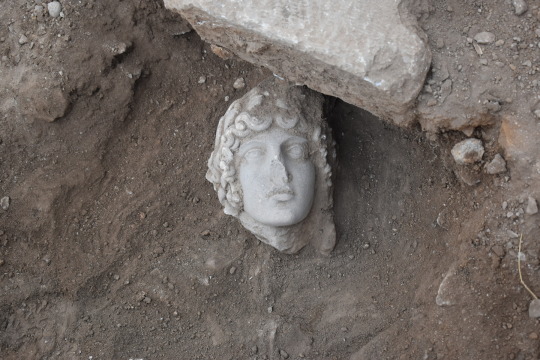
The Marble Head of Apollo Unearthed in Greece
The excavation, carried out by a group of students of the Aristotle University of Thessaloniki in the archaeological site of Philippi Kavala, brought to light important findings. Among other things, they discovered a rare head of Apollo dating back to the 2nd or early 3rd century AD.
The statue dates back to the 2nd or early 3rd century AD and it probably adorned an ancient fountain.
Natalia Poulos, Professor of Byzantine Archaeology, led the excavation, which included fifteen students from the Aristotle University of Thessaloniki (11 undergraduates, 2 master’s, and 2 PhD candidates), Assistant Docent Anastasios Tantsis, and Professor Emeritus of Byzantine Archaeology Aristotle Mendzo.
Archaeologists say, this year the excavation continued east of the southern main road (decumanus) at the point where it meets the northern axis of the city (the so-called “Egnatia”). The continuation of the marble-paved road was revealed, on the surface of which a coin (bronze phyllis) of the emperor Leo VI (886-912) was found, which helps to determine the duration of the road’s use. At the point where the two streets converge, a widening (square) seems to have been formed, dominated by a richly decorated building.
Archaeologists say evidence from last year’s excavations leads them to assume it was a fountain. The findings of this year’s research confirm this view and help them better understand its shape and function.

The research of 2022 brought to light part of the rich decoration of the fountain with the most impressive statue depicting Hercules as a boy with a young body.
The recent excavation (2023) revealed the head of another statue: it belongs to a figure of an ageneous man with a rich crown topped by a laurel leaf wreath. This beautiful head seems to belong to a statue of the god Apollo. Like the statue of Hercules, it dates from the 2nd or early 3rd century AD and probably adorned the fountain, which took its final form in the 8th to 9th centuries.
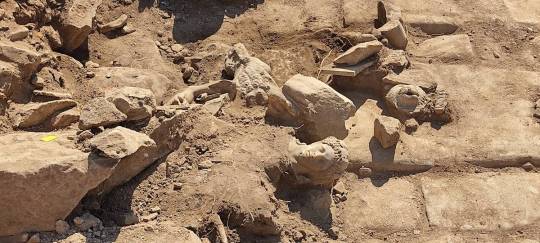
In classical Greek and Roman religion and mythology, Apollo is one of the Olympian gods. He is revered as a god of poetry, the Sun and light, healing and illness, music and dance, truth and prophecy, and archery, among other things.
Philip II, King of Macedon, founded the ancient city of Philippi in 356 BC on the site of the Thasian colony of Crenides near the Aegean Sea. The archaeological site was designated a UNESCO World Heritage Site in 2016 for its outstanding Roman architecture, urban layout as a smaller reflection of Rome itself, and significance in early Christianity.
By Oguz Buyukyildirim.
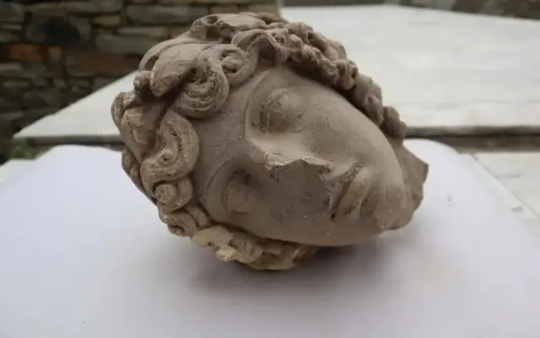
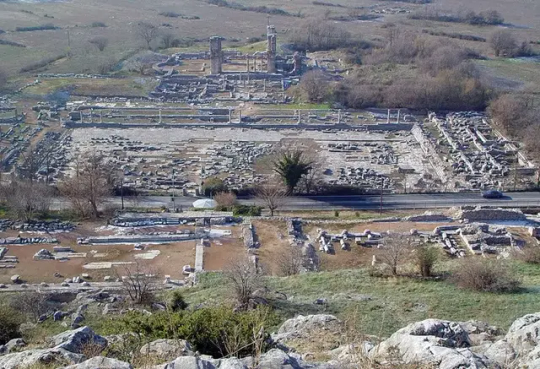
#The Marble Head of Apollo Unearthed in Greece#Philippi Kavala#marble#marble statue#ancient artifacts#archeology#archeolgst#history#history news#ancient history#ancient culture#ancient civilizations#ancient greece#greek history#greek art
193 notes
·
View notes
Text
Newbie

Spencer Reid x Black!Fem!Reader Synopsis: Reader is new to the BAU and discovers that she has similar qualities to another coworker…
A/N: This is based off that one Spencer Reid fic that was basically the same concept but I can’t remember the exact name 😔 + I kinda had early seasons Reid in mind for this but it really goes for any season
“Did you hear about the new kid?” Penelope asked, making her way over to JJ’s desk.
“New kid?” She questioned.
“Well, y’know. She’s around Reid’s age, and I heard that she’s practically just like him. Besides some physical differences.” She explained.
“Oh yeah, I saw. It’s pretty weird.” Elle told them.
“Wait, shh! Here she comes now!” Penelope whisper shouted as you made your way over to them.
“Um, do you guys know where Hotchner’s office is?” You asked them awkwardly, making them glance at each other, obviously entertained.
“Yeah, but he’s in a meeting right now.” Penelope lied.
“Oh…” You said, before quickly glancing at Penelope’s shirt, which was littered with cartoon cats. “Do you like cats?” You asked her, still looking at her shirt, causing her to raise an eyebrow.
“Yeah…why?”
“Did you know that most cats are actually lactose intolerant? Some can love milk, but most are. Plus, cats can’t taste anything sweet.” You informed, holding up your index finger.
The three women looked at each other in amusement. “Really?” You nodded.
“Also, did you know that the first black female FBI agent was Sylvia Elizabeth Mathis? I know that fact technically only applies to me, but…interesting factoid I guess..” You rambled.
“It’s worse than we thought…” Penelope whispered. “What is?” You asked, worried.
“You know, I think there’s someone that you’d get along pretty well with…” JJ suggested.
“Really? Who?”
“Reid!” The three of them called, making a tall and slender young man come rushing to JJ’s desk.
“New initiative.” Penelope said.
“You two have…a lot in common.” JJ finished.
You hold your hand out for him to shake, and he does as such.
“Nice to meet you…”
“Y/N.” You finished. “Did you know that the earliest depiction of a handshake was from an ancient Assyrian relief from-”
“9th Century BC? I know.” Spencer finished.
“Well…shucks. I’m not exactly used to not being the smartest.”
“You can be the smartest female! I’m willing to give up my title..” Penelope half-joked, making you chuckle.
“That’d be nice.”
“Well, Reid? Why don’t you show the young lady around?”
“Sure.” He replied, motioning for you to follow him.
You two had barely left the spot when Hotchner emerged from his office.
“Reid,” He called, making both of you stop in your tracks. “I see you’ve beaten me to welcoming our new kid.” He said smiling.
“Sorry sir,” Reid sheepishly apologized. “If you want, I can-”
“No no, I think you’ve got it.” He told him with a wink.
#spencer reid x black reader#spencer reid x black!reader#spencer reid x reader#criminal minds#criminal minds x reader#spencer reid
200 notes
·
View notes
Text
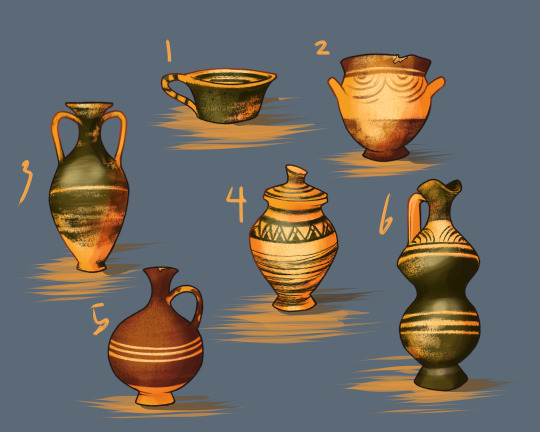
Doodles of ancient greek pottery in the protogeometric style (10th to 9th century BC)
Cup from either Aegina, Attika, Corinth, Argos or Boethia. Honestly I'm not sure and I'm too tired to do research now. It's on exhibit in Aegina if you want to find out so badly you nerd
Skyphos on exhibit in Athens
Amphora (no shit)
Pyxis with lid, 10th century BC
Lekythos, circa 1050 BC, on exhibit in Würzburg
Double oinochoe, 9th century BC, on exhibit in Athens
229 notes
·
View notes
Text
deep in the obsession
ok so IDK how much I've talked about my Special Interest in the Bronze Age on here. At one point (like nanowrimo of 2003 or so) I was trying to write a novel set in the British Isles Bronze Age and I researched as much as I could and there just wasn't much information and I wrote some stuff anyway but it petered out. And ever since then I've kept checking back on various avenues of research and every time there's a new find I'd read as much as I could find about it. And then they discovered the remains of a pile-dwelling settlement in the Fens in England and they've finally just now published the results of that? Well of course I've been obsessively reading about it. (I had actually emailed the Cambridge Archaeology Unit a couple of months ago to ask where I could find the publications, so the timing was good.)
I mean the long and short of it is, they've got a site exposed by modern quarrying activity, which consists of five remaining buildings, which burned down and collapsed into the river channel with all their contents in the 9th century BC; the inhabitants escaped with very few of their possessions, and the rest of the assembly of the items they used in their daily lives are largely present, very well-preserved; whole sets of pots and woodworking tools, as well as textiles and textile-processing materials, foodstuffs, wooden tools, and enough building materials to almost entirely reconstruct their dwellings; a enormous wealth of information about their diets, their ways of living, even some feel for their aesthetic sensibilities. The circumstances of the buildings' collapse even means we know how they laid out their living spaces.
So I am going to infodump about what I've pulled out of these rather dense and dry reports (I have zero complaints, they're perfectly appropriately-written), so buckle up.
Firstly, if you want to read these yourself, the publications are open access PDFs hosted on the Cambridge Archaeology Unit's website here.
There are also a fantastic series of blog posts both from during the excavation and from during the initial analytical "post-ex" phase on the site's website, which I devoured while waiting for the final reports.
I admit I was first drawn to the whole thing, when I first saw stories about it, because of the mystery. It seems to have been a whole settlement, a village maybe, and it all burned down at once, and no humans seem to have died in it, but everyone left everything behind, even leaving a dog in one of the buildings, and some penned little lambs in a couple of them-- what caused this? Were they attacked? Were they forced out of it? It had a palisade around it as if for defense, did they build it because they were afraid, and rightfully so?? Why did they not come back to try to salvage anything? The water would have been shallow, surely they could at least get their axe-heads and things back.
But the thing that has sustained my interest now is that it appears to have been an unexceptional village after all. There's no evidence that these were elite people living here. There weren't any unambiguous weapons found-- part of a broken sword, in what was obviously a recycle bin (a wooden bucket), waiting along with some broken chisels and a bent axe and part of a broken bronze bucket for a trip back to the nearest metalworker. Some spears, but likely used for hunting, stored outside the houses all together leaned up against the palisade under an overhanging roof eave. Axes, but the sheer quantity of woodworking in the site means they were very obviously woodworking tools, and weapons only by technicality.
Other contemporaneous sites are preserved so incompletely that there are always "was this a place people dwelled or was it a ceremonial gathering place" kinds of questions. Artifacts are found either discarded in middens, broken, or deposited in hoards, "ceremonially?". But all this stuff is in-context, in the house, which burned down and collapsed straight down. This was the kitchen area, obviously; all the houses had most of their pots in the same approximate spot, caches of grain in the same area. This corner is where we find stuff they were working on-- one house has probably a loom, and tons of textile-related stuff scattered around it. (There's only evidence for a loom in one or maybe two of the buildings, but there are spindle whorls and bobbins of thread in three; several spinners providing one weaver, as is common throughout history.)
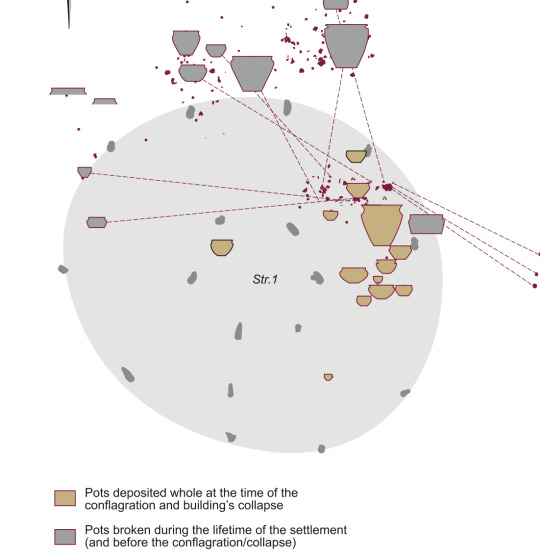
Some of the pots had been broken before the fire, and some of them had been partially discarded and partially kept, like for example a well-shaped broken bit of rim was being used as a scoop or something, while the little unusable shards had gotten chucked into the river where they threw their trash; the archaeologists could reunite fragments to prove this, and could derive the information that these shards would all be associated with the same house; they weren't shared, they were using the broken pot in the same house where they'd used it before it was broken; they seem to have cooked their meals separately, and kept separate inventory of basic household necessities. But the extra stuff seems to have been stored in the communal storage shed, so they could all get to it.
There's a large but incomplete sheet of bark that in places has a second sheet adhered to it with moss in between, which was likely bedding.
There are textiles, not just woven ones but also weft-twined ones made from lime bast cord-- mats, or hats, or capes. There's a knotted fishing net that was rolled up and in a pile with other things in an area that seems to have been a storage shed of sorts. (Near the "recycle bin" full of broken metal.) There's a collection of prepared fiber, ready to be made into cordage or spun into thread, and it's all prepared the same way in standard-sized bundles-- tantalizingly, regular enough as if for trade, stored in that storage shed next to a nested set of new pots-- like somebody had bought or made them and they weren't put to use yet, OR someone had made extra they intended to trade offsite for stuff they couldn't make themselves.
The whole sets of pots are broadly the same among households-- similar numbers of large vs. small, coarse vs. fine. They all resemble one another, though some are better-made than others-- as if several people made them, but under the guidance of one experienced worker.
Several pots and wooden containers have food residues. Hauntingly, there's a ceramic pot that was still half-full of porridge, with a wooden spatula/spoon still stuck in it. The porridge was made of ground wheat cooked in a liquid containing animal fats from a ruminant-- either sheep/goat or red deer-- possibly an early example of frumenty.
Enough of the structural timbers remain from the buildings, many with markings on them from where other structural elements were touching them and alternately exposed/protected them from fire so it is possible to reconstruct shapes and connections in more detail than if they were unburnt ruins, that the buildings can be nearly completely reconstructed, which is novel because most buildings of this era are known only from footprints/post holes. Almost no material survived from the walls, but because of these ghost "protection marks" it's possible to know that the walls existed, how wide they were, that they were attached in a particular spot, that they were made of a series of small uprights-- and to then surmise that some of the fragments of "wattle", woven panels, must have come from the walls in some cases. And it's possible to reconstruct the innovative, never-elsewhere-seen sprung floor system of bowed joists that kept the floors securely above the water below.
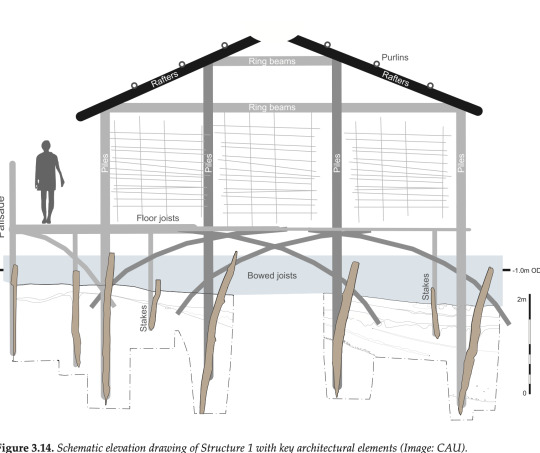
Anyway, I've devoured Vol I and am most of the way through scouring Vol II for interesting tidbits.
Yes of course I want to write a novel with this as the setting but I also am just completely fascinated.
100 notes
·
View notes
Photo

The territorial history of Armenia and Azerbaijan
“Atlas of the Ethno-Political History of the Caucasus”, Arthur Tsutsiev, Yale University Press, 2014
The Armenian historical view centers on the global threat associated with the expansion of Turkic-speaking tribal groups into former Armenian territories, including Artsakh (Karabakh). Today's Azerbaijan is itself largely the former Caucasian Albania, a land which became Christian in the middle of the 4th century, submerged from the 11th century by Turkish invasions and which, in the 19th century, completely disappeared, transformed into a territory Turkish and Muslim.
Azerbaijan comes from the Democratic Republic of Azerbaijan of 1918-1920, created following Turkish intervention and taking its name from a Persian region located further south. This part of Eastern Transcaucasia, incorporated into Russia between 1803 and 1828, is in fact a former Persian territory with an indigenous sedentary Armenian population and a nomadic Turkish-Kurdish population who arrived later.
After the First World War, the Armenians would not have a state in the former Ottoman territories but a small formerly Russian territory around the city of Yerevan, southwestern part of the Transcaucasian Federative Democratic Republic (April -May 1918) which takes the name of the Democratic Republic of Armenia. From June 1920, the Kemalist Turkish nationalists began negotiations with the Soviets and the demarcation of the borders of the Armenian Soviet Socialist Republic (born December 2) was ultimately to the detriment of the Armenians themselves, since it did not does not include Karabakh, included entirely in Azerbaijan, at the insistent request of the Turks.
From then on, the Armenians are a people who have the particularity of being deprived of a large part of their historical territory even though it dates back to the 9th century BC with the kingdom of Urartu and its territorial peak dates from the end of the 2nd century BC when King Tigranes dominated a territory stretching from the Caspian to the Mediterranean.
by cartesdhistoire
146 notes
·
View notes
Text
Nineveh: Exploring the Ruins of the Crown City of Ancient Assyria | Ancient Origins
Nineveh is mentioned several times in the Hebrew & Christian Bibles. It's mentioned in: Genesis, II Kings, Isaiah, Jonah, Nahum, Zephaniah, Matthew, & Luke.
Author’s Note: Nineveh is mentioned several times in the bible. In both the Old & New Testaments. This also means that Nineveh is mentioned in the Jewish holy book, the Tanakh. It’s mentioned in: Genesis, II Kings, Isaiah, Jonah, Nahum, Zephaniah, Matthew, & Luke.
https://www.ancient-origins.net/ancient-places-asia/nineveh-0010595
View On WordPress
#13th century#16th century#1849#2016#2nd Millennium BC#612 BC#7th Millennium BC#9th century BC#Acropolis#Adad Gate#Ancient Assyria#Ashurnasirpal II#Assyrian Empire#Atabegs of Mosul#Babylonians#Chalcolithic Age#Hassuna-Samarra#Hurrian Kingdom of Mitanni#Iraq#Ishtar#King Sennacherib#Library of Ashurbanipal#Mashki Gate#Medes#Mesopotamia#Mosul#Neolithic#Nineveh#Scythians#Shalmaneser I
0 notes
Text
Diamastigosis.
—warnings; implied oral (f receiving), religious references (Greek), bffs to lovers, idolatry, inexperienced!Reader, nerdy!Reader, fem!Reader.
—notes; wrote this years ago, like back in ‘21. Thought I’d post it, as I really like it.
—tagging; @e-dubbc11 @firexfate @aoi-targaryen @kayhi808 @terry2227 @danzer8705

x
“You’re the only god in my temple.” You had said, clinging to his hair, heels digging into his back, as you sighed, every swipe of his tongue making you more desperate for him. A few drinks at the bar, and you’d worked up the courage to ask your best friend to teach you what he knew.
And he couldn’t deny you. “Please, Billy, please,. I’ll be a good for you.” You breathed softly, tugging on his sweater, and all he could think about was how sweet you begged for him. That he wanted you a ruined mess in his bed.
He’d sipped his beer, looking at you out of the corner of his eye, eyebrow raised. He touched your thigh on the bar stool, making you gasp a little. “Gonna regret it?” He asked, self deprecating.
“Could never regret being with you, Billy.” You said, pulling your bottom lip between your teeth.
He pulled your lip out, trying not to have you right there, eyes dark like pits. He hummed, “You’re sweet, baby. Sure.”
“Yeah? Gonna worship at my altar?” He asked now, burying his face in your warm, wet heat, making eye contact with you. His hands held your thighs, as they squeezed around his head.
“Yes,” you hissed, looking down at him, eyes idolatrous, “Did you know that in the 9th century BC, there were ritual flagellations for Artemis? It was called diamastigosis.” You told him, breathlessly, trembling and writhing against his face, as he worked you into a mess. He was amused at your textbook knowledge of sex, rather than having a carnal one. “Suffering is the highest form of worship. I’d suffer for you, Billy.”
His teeth dragging across your pussy was his only response, as he swore to keep you by his side, your sweet worship for his own.
52 notes
·
View notes
Text
here's one that's even more bonkers that I didn't report on. it involves writers over at Haaretz being very incompetent.
on the age of chickpea cultivation in Palestine, people variously say 10,000 BC, 8400 BC, 8000 BC, 7000 BC &c. as if at random.
foodtimeline.org (which supposedly provides sources to the researcher but has betrayed me many, many times) cites: Food in the Ancient World From A to Z, Andrew Dalby [Routledge: London] 2003 (p. 84).
Dalby says:
Chickpea, one of the oldest cultivated pulses in the Near East. Chickpeas were grown in Palestine by 8000 BC.
this book is actually useless from a research perspective and belongs to what I like to call the "just some guy saying something" approach to making claims. none of the works cited at the end of the page on chickpeas (yes! none of the claims are associated with a particular work! there are no footnotes! so if you want to trace a particular claim, you've gotta look in each work mentioned! lol!) are scholarly works either, all of them also belong to the "some guy saying something" school of thought, and, most dizzyingly, none of them contain the 8000 BC claim!
okay, let's take another tack. wikipedia says:
"The earliest well-preserved archaeobotanical evidence of chickpea outside its wild progenitor's natural distribution area comes from the site of Tell el-Kerkh, in modern Syria, dating back to the early Pre-Pottery Neolithic period around (c.8400BCE). [12]"
[12] turns out to be an article titled "The Strange Origin Story of the Chickpea" on Haaretz (ugh), which is hardly a scholarly source, but perhaps it cites one! Haaretz says:
The question addressed in a new paper published in May in the journal of Molecular Biology and Evolution is historic: how the domestic chickpea arose and spread, first apparently to the Middle East – signs of chickpea domestication were identified in el-Kerkh, Syria, that may be as old as the 10th millennium B.C.E. – and onwards, the western Mediterranean and to Asia, and to eastern Africa (specifically, Ethiopia).
the particularly sharp-eyed among you may notice that "10th millennium BC" (10,000 to 9,001 BC) is a different claim from "8400 BC," but, oh well, let's click that link.
it's a paper titled "Historical Routes for Diversification of Domesticated Chickpea Inferred from Landrace Genomics." it contains no references to the finds in el-Kerkh, or to a 10th millennium BC claim, or a 9th century BC (which the year 8400 belongs to) claim; it's more about developing a model to trace spread, rather than attesting evidence for any particular date. the author of this article must have just added the information about the site in Syria from, idk, their own background knowledge? lol.
but let's keep pushing this. elsewhere in the same article, a paper titled "Draft genome sequence of Cicer reticulatum L., the wild progenitor of chickpea provides a resource for agronomic trait improvement" is linked. this paper contains in its introduction the claim:
Chickpea was domesticated with wheat, barley, peas and lentil as a member of West Asian Neolithic crops during the origin of agriculture around 10,000 years ago with the oldest archaeological evidence from 7500 B.C.4,5
also a very different claim from both "8400" and "10th millennium BC", but okay, let's try to trace this one.
citation 4 is a paper titled "Evolution of cultivated chickpea: four bottlenecks limit diversity and constrain adaptation," and it also has to do with something completely different from archaeological evidence for chickpea cultivation. in reference to the claim it is cited to support, it contains only the sentence:
Chickpea is [...] associated with the origin of agriculture in the Fertile Crescent some 10000 years ago.
for this rather vague claim, they themselves cite two other sources: 2000, Lev-Yadun et al. "The cradle of agriculture," Science 288, 1602-1603; and 1999, Zohary D, Hoph M "Monophyletic vs. polyphyletic origin of the crops on which agriculture was founded in the Near East," Genetic Resources and Crop Evolution 46, 133-142.
citation 5 is Harlan J. R. 1971, "Agricultural origins: centers and noncenters," Science, 174, 468–474. this one says, summarizing other research, that in the "Near East" (bleucgh)
barley, einkorn, emmer, peas, lentils, flax, vetch, and chickpeas appear to have been domesticated, together with sheep, goats, pigs, and possibly cattle.
the source for this sentence is G. Wright and A. Gordus, Amler. J. Archaeol. 73, 75 (1969).
okay, well, this is starting to get obviously silly; trying to trace these claims further and further back until a primary report of an actual archaeology site is found is clearly pointless, especially since at this rate the find would be from like 1954 and almost certainly new evidence has come to light since then.
let's try something else. despite the fact that Haaretz's "signs of chickpea domestication were identified in el-Kerkh, Syria, that may be as old as the 10th millennium B.C.E" claim didn't actually come from the source that they cited, surely it must have come from somewhere?
I find two papers describing the finds in el-Kerkh, written by the same team. "The origins of cultivation of Cicer arietinum L. and Vicia faba L.: early finds from Tell el-Kerkh, north-west Syria, late 10th millennium B.P." is the one that deals specifically with the chickpea findings.
aha! here, perhaps, is the source of the "10th millennium BC" claim! I suspect someone misread the title of this article, and read nothing else!!
the trouble is twofold: 1. "10th millennium BP" is given as the age of the site, not specifically of the cultivated chickpeas that were found; and 2:
"BP" is not "BC"!!!
"BP" is a metric of time used in carbon dating. it means "before present." the "present" is set to the year 1950, since this is close to when carbon dating was introduced. 10,000 years before 1950 is 8050 BC, and this is the absolute oldest date allowable based on just the title of the paper.
however, if we actually read the paper (or, I mean, skim it for a date, lol), we finally find something concerned with dating a particular site rather than making a genetic model; still better, we find this beautiful, readily comprehensible table shewing us "Archaeobotanical records for C. arietinum [...] in the early Neolithic periods", citing a specific site, the number of beans found there, the estimated date BP of those beans based on carbon dating, and a reference to the paper that details each find:

the "this paper" reference based on the Tell el-Kerkh site gives the date
9350-9165 B.P.! that's 7400-7215 BC! we have a date range at last!
other papers in this chart give estimates that are more recent (e.g. 9320 - 9175 BP), based on papers from the 80s and 90s.
so, if this paper is more recent that any other citation I found during this whole journey (2006), and it claims to have pushed the date on the earliest piece of archaeological evidence for cultivation of the chickpea back (note that archaeological is different than evidence based on literature, genetics, &c.), then where on earth are "8000 BC" and "8400 BC" coming from? I still don't know.
tl;dr: a lot of people say that wikipedia, research blogs online, popular news publications, and things of that ilk are not sources on their own, but that they can be a good starting point to help you find sources. I no longer believe that to be the case. you are better off just starting in jstor or google scholar &c. and ignoring everything else. the claims you find in the latter way may, however, still be wild goose chases even if they are published in scholarly journals. the citation webs in academic journals are dizzying and people rarely trace a claim back to its actual origin, instead content to cite a source that cites a source that cites a source that cites a source........
anyway. I share my humble stories simply for entertainment purposes only.
49 notes
·
View notes
Text

Pythia: Oracle and High Priestess of Delphi
Talon Abraxas
Situated on the south-western spur of Mount Parnassus in the valley of Phocis, Delphi was associated with the Greek god Apollo. According to legend, the hill was guarded by a giant serpent called Python, who was a follower of the cult of Gaia (Earth), for hundreds of years. After killing Python, Apollo claimed Delphi as his own sanctuary.
Perhaps this legend was a reflection of actual events. During the Mycenaean period (14th-11th centuries BC), there were small settlements in Delphi dedicated to the Mother Earth deity. Subsequently, the worship of Apollo was established between the 11th and 9th centuries BC. By the 8th century BC, Delphi was already renowned internationally for the prophetic powers of the Pythia. Yet, it was only in the following century that the Oracle became a Panhellenic institution, when Apollo’s advice was sought by the Greek cities on important matters of state.
Pythia was the name given to any priestess throughout the history of the Temple of Apollo at Delphi. The priestess was a woman over 50 years of age who lived apart from her husband and dressed in maiden’s clothes. According to Plutarch, who once served as a priest at Delphi, the Pythia first enters the inner chamber of the temple ( Adyton). Then, she sits on a tripod and inhales the light hydrocarbon gasses that escape from a chasm on the porous earth.
43 notes
·
View notes
Text

Mask
China, Western Zhou dynasty ( 1046–771 BC ), about 9th century BC
The function of this mask is not certain. It may have served as a bridle plaque for a horse, an ornament for a chariot, or, sewn onto leather, as chest armor for a soldier.
41 notes
·
View notes